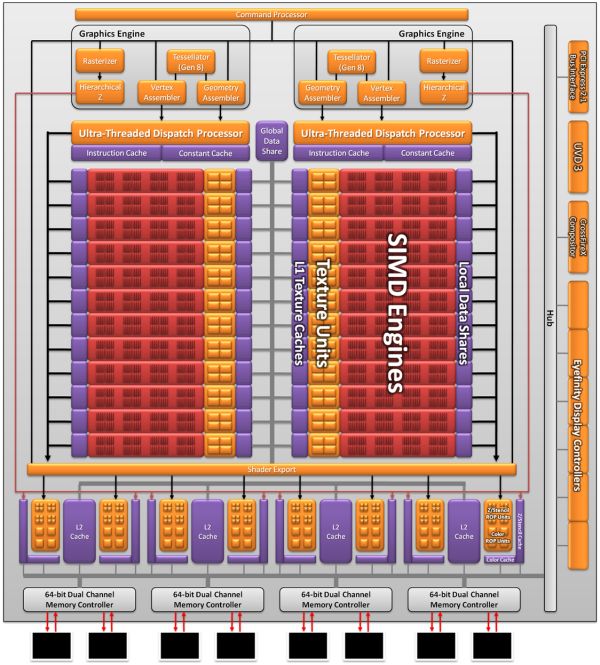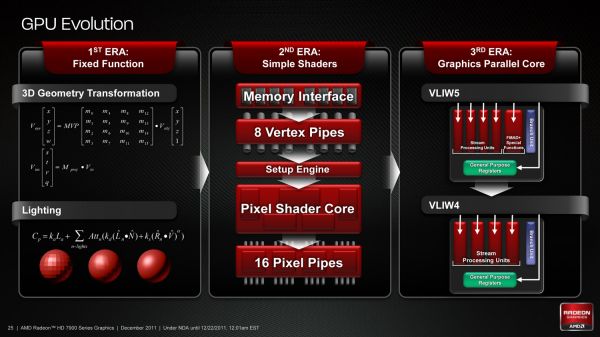AMD Radeon HD 7970 Review: 28nm And Graphics Core Next, Together As One
by Ryan Smith on December 22, 2011 12:00 AM EST- Posted in
- GPUs
- AMD
- Radeon
- ATI
- Radeon HD 7000
A Quick Refresher: Graphics Core Next
One of the things we’ve seen as a result of the shift from pure graphics GPUs to mixed graphics and compute GPUs is how NVIDIA and AMD go about making their announcements and courting developers. With graphics GPUs there was no great need to discuss products or architectures ahead of time; a few choice developers would get engineering sample hardware a few months early, and everyone else would wait for the actual product launch. With the inclusion of compute capabilities however comes the need to approach launches in a different manner, a more CPU-like manner.
As a result both NVIDIA and AMD have begun revealing their architectures to developers roughly six months before the first products launch. This is very similar to how CPU launches are handled, where the basic principles of an architecture are publically disclosed months in advance. All of this is necessary as the compute (and specifically, HPC) development pipeline is far more focused on optimizing code around a specific architecture in order to maximize performance; whereas graphics development is still fairly abstracted by APIs, compute developers want to get down and dirty, and to do that they need to know as much about new architectures as possible as soon as possible.
It’s for these reasons that AMD announced Graphics Core Next, the fundamental architecture behind AMD’s new GPUs, back in June of this year at the AMD Fusion Developers Summit. There are some implementation and product specific details that we haven’t known until now, and of course very little was revealed about GCN’s graphics capabilities, but otherwise on the compute side AMD is delivering on exactly what they promised 6 months ago.
Since we’ve already covered the fundamentals of GCN in our GCN preview and the Radeon HD 7970 is primarily a gaming product we’re not going to go over GCN in depth here, but I’d encourage you to read our preview to fully understand the intricacies of GCN. But if you’re not interested in that, here’s a quick refresher on GCN with details pertinent to the 7970.
As we’ve already seen in some depth with the Radeon HD 6970, VLIW architectures are very good for graphics work, but they’re poor for compute work. VLIW designs excel in high instruction level parallelism (ILP) use cases, which graphics falls under quite nicely thanks to the fact that with most operations pixels and the color component channels of pixels are independently addressable datum. In fact at the time of the Cayman launch AMD found that the average slot utilization factor for shader programs on their VLIW5 architecture was 3.4 out of 5, reflecting the fact that most shader operations were operating on pixels or other data types that could be scheduled together
Meanwhile, at a hardware level VLIW is a unique design in that it’s the epitome of the “more is better” philosophy. AMD’s high steam processor counts with VLIW4 and VLIW5 are a result of VLIW being a very thin type of architecture that purposely uses many simple ALUs, as opposed to fewer complex units (e.g. Fermi). Furthermore all of the scheduling for VLIW is done in advance by the compiler, so VLIW designs are in effect very dense collections of simple ALUs and cache.
The hardware traits of VLIW mean that for a VLIW architecture to work, the workloads need to map well to the architecture. Complex operations that the simple ALUs can’t handle are bad for VLIW, as are instructions that aren’t trivial to schedule together due to dependencies or other conflicts. As we’ve seen graphics operations do map well to VLIW, which is why VLIW has been in use since the earliest pixel shader equipped GPUs. Yet even then graphics operations don’t achieve perfect utilization under VLIW, but that’s okay because VLIW designs are so dense that it’s not a big problem if they’re operating at under full efficiency.
When it comes to compute workloads however, the idiosyncrasies of VLIW start to become a problem. “Compute” covers a wide range of workloads and algorithms; graphics algorithms may be rigidly defined, but compute workloads can be virtually anything. On the one hand there are compute workloads such as password hashing that are every bit as embarrassingly parallel as graphics workloads are, meaning these map well to existing VLIW architectures. On the other hand there are tasks like texture decompression which are parallel but not embarrassingly so, which means they map poorly to VLIW architectures. At one extreme you have a highly parallel workload, and at the other you have an almost serial workload.

Cayman, A VLIW4 Design
So long as you only want to handle the highly parallel workloads VLIW is fine. But using VLIW as the basis of a compute architecture is going is limit what tasks your processor is sufficiently good at. If you want to handle a wider spectrum of compute workloads you need a more general purpose architecture, and this is the situation AMD faced.
But why does AMD want to chase compute in the first place when they already have a successful graphics GPU business? In the long term GCN plays a big part in AMD’s Fusion plans, but in the short term there’s a much simpler answer: because they have to.
In Q3’2011 NVIDIA’s Professional Solutions Business (Quadro + Tesla) had an operating income of 95M on 230M in revenue. Their (consumer) GPU business had an operating income of 146M, but on a much larger 644M in revenue. Professional products have much higher profit margins and it’s a growing business, particularly the GPU computing side. As it stands NVIDIA and AMD may have relatively equal shares of the discrete GPU market, but it’s NVIDIA that makes all the money. For AMD’s GPU business it’s no longer enough to focus only on graphics, they need a larger piece of the professional product market to survive and thrive in the future. And thus we have GCN.











292 Comments
View All Comments
tw99 - Thursday, December 22, 2011 - link
I just wanted to say thank you for including the 8800 GT in some of your benchmark charts. Even though its dated hardware, including it in your comparisons illustrates the punch that the newer hardware has and assists in decision making for people like myself looking to upgrade from their current setup, unlike most benchmarking articles on other sites that like to compare only the very recent generations, not taking consideration what people would have now.Leyawiin - Thursday, December 22, 2011 - link
I wonder if the Arctic Cooling Twin Turbo II I have sitting in the closet (and haven't ever used) would fit on one of these? Its compatible for up to an HD 6970 so I know it can cool one of these sufficiently (if the mounting holes match their old cards). Maybe I should wait to see what the HD 7950 is like - buying the top of the line card at launch usually isn't smart from a value standpoint.Leyawiin - Thursday, December 22, 2011 - link
Its all a moot point anyway. Damn "soft launch" not available for at least three weeks. Just a marketing ploy to keep people from buying Nvidia's top cards at the moment. If you aren't ready to sell your cards, keep your mouth shut.james.jwb - Thursday, December 22, 2011 - link
I have an Arctic Cooling Extreme Plus II on a 6970 and wouldn't use the lower sized versions. But Im also interest to know if it'll fit the 7970. But in all honesty, until these prices come down I won't go near this card, the performance increases just aren't worth it for most people.Dark Man - Thursday, December 22, 2011 - link
It looks like page 7 and 8 got the same content ?Dark Man - Thursday, December 22, 2011 - link
Sorry, page 8 and 9Dark Man - Thursday, December 22, 2011 - link
Page 13 and 14, tooRyan Smith - Thursday, December 22, 2011 - link
We added a couple of pages this morning; you're probably seeing the cascade effect of the rest of the pages being pushed back.evilspoons - Thursday, December 22, 2011 - link
I'd just like to say that I found this review harder to read than the usual stuff on Anandtech. Everything seemed wordy - if there was an opportunity to use a sentence instead of a word, the sentence was used.Good job on the comprehensive information, but trim the fat off the writing next time, please!
RussianSensation - Thursday, December 22, 2011 - link
Even if it's a 6 months lead, 2012 is so far looking like a year full of console ports. We have Syndicate (February 21, 2012), then Mass Effect 3, Max Payne 3 (both on March 6). Those games will get crushed by modern GPUs. HD7970 is an amazing buy for those who are building a new system now/soon and planned to spend $500+ on a GPU. But for current GPU owners, it's not enough of a performance boost imho. And on its own, it's still not fast enough for 2560x1600 either. It's a good card, but since modern GPU generations last 18-24 months, it's too early to call it great.